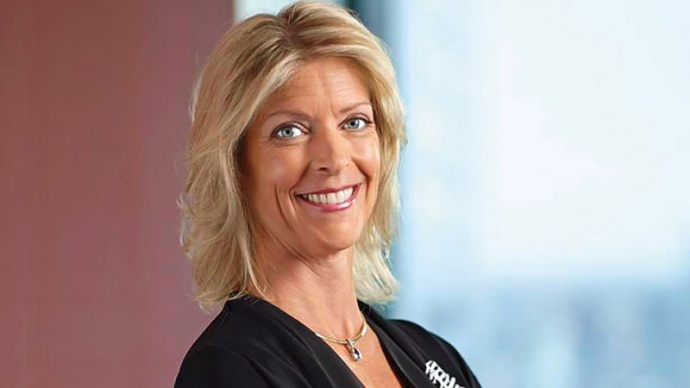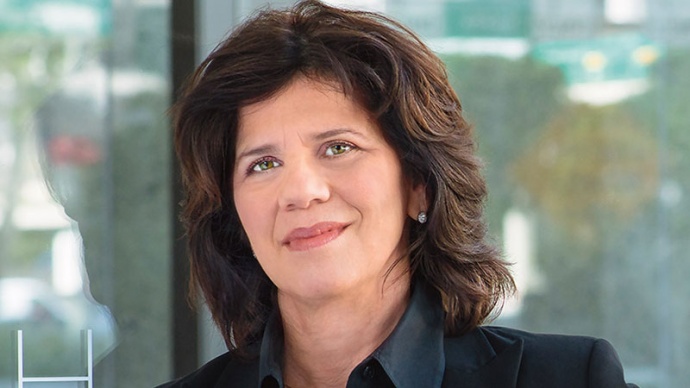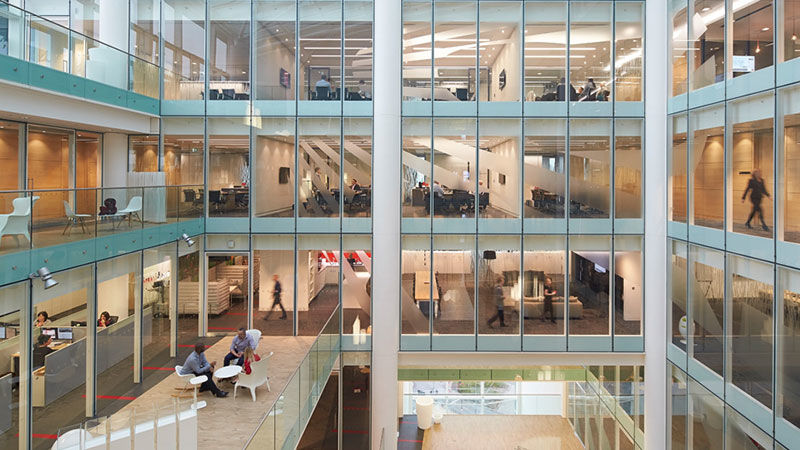Offices of Gowling WLG in Birmingham, UK pictured above.
Seeking more collaboration and accommodation
When McCarthy Tétrault, one of Canada’s premier law firms, invited its partners, lawyers and staff to move into the firm’s new open office spaces in Quebec City last summer, they videotaped their people’s reactions.
“It was absolutely priceless – to see how they loved the space and that energy, and how they were connecting with people, having a coffee together and exploring the new space,” said Tracie Crook, McCarthy Tétrault’s Chief Operating Officer. “To me, that was one of those ‘Wow’ moments that I wasn’t anticipating.”
McCarthy Tétrault became the first major law firm in Canada to adopt what has become a growing – albeit cautious – trend among law firms both in the U.S. and around the world: utilizing office space that creates more open, communal work areas with more flexible, tech-connected workstations while doing away with secluded, individual offices of dark oak and smoked glass that typified the traditional law firm years ago. The idea – supported by operating officers like Crook as well as architects and workflow and generational specialists – is that an open office design breaks down the hierarchical barriers and creates a space for more collaboration, technological innovation and accommodation of the multigenerational workforce that comprises a modern law firm. In a sense, it’s building the office of tomorrow for the rainmaker of tomorrow, which in many firms may now be found in the ranks of the younger, millennial-age lawyers rather than the older, baby boomer partners.

Of course, law firm traditionalists – or curmudgeons – point out problems with the loss of the coveted corner office, and what that could mean for firm culture and status, employee motivation and internal advancement.
That’s why the legal industry has embraced the open office phenomenon gingerly, often taking half-steps. And that includes McCarthy Tétrault, which actually moved into a hybrid space. “It has glass offices as well as open work areas, quiet rooms and other communal working locations,” Crook explained, adding that the floor plan allows people to move to different spaces and work locations, depending on what they need to achieve. “Everyone was given the technology that allows them to move throughout the floors, both with headsets and computers. They all have that flexibility.”
McCarthy Tétrault also is redesigning its Vancouver office, which is expected to be finished this spring. Beyond that, they are looking at either restructuring or relocating several office spaces in Toronto and Montreal.
The firm is not alone. DLA Piper redesigned its new offices in Sydney, Australia to an open office space with the stated intention of giving junior lawyers more collaborative work time with senior partners. UK tax giant CMS Cameron McKenna redesigned its London office, ditching all its landline phones in the process. The new space allows the firm to actually hold 10% more staff in 30% less space. (Approximately one-third of London law firms have moved to open space plans, realtors estimate, with only a few still featuring individual offices.)
And in June, Nixon Peabody moved its Washington, D.C. office, leaving its traditional space for one in which all members – partners, junior associates and paralegals – have the same-size work space. The previous corner offices were turned into team meeting rooms. Other law firm heavyweights like Proskauer Rose; Orrick, Herrington & Sutcliffe; Paul Hastings; and Holland & Knight also have incorporated aspects of the open space movement in recent office redesigns or relocations in the U.S., though again, more tentatively than their non-U.S. counterparts.
“It is a concept that hasn’t taken full hold in the U.S., but it has really begun to emerge,” said Barbara Dunn, Studio Director and Principal at Gensler, a global architecture and design firm. “It used to be that no firms in the U.S. were looking at this, but now more are, and I think you will see pockets of open space plans emerge when firms redesign or relocate now.”
Of course, these dramatic reworkings of traditional legal work spaces don’t happen in a vacuum or without the full, on-board cooperation of the vast majority of the firm, as McCarthy Tétrault’s Crook can attest. “Any time you go through any change there is hesitation,” she said, adding that everyone in the two Canadian offices was brought along throughout the process. “They were involved in the work study. They were involved when we reviewed the technology. When we were looking at implementing the layout of it – the picking out the colors. So they were really involved in the entire process.”
Gensler’s Dunn agreed that many factors – the firm’s culture and vision for the future, its generational mix of employees, its technological needs and its client profile, among others – all need to be considered before a firm can embark on a dramatic redesign into a markedly different workplace. “A firm can’t simply mandate this, you have to go through a process,” Dunn said.
Beyond the aesthetics and the partner persuasion, of course, significant cost-savings has become a prime motivator in law firms’ consideration of this model. “Initially, I would say we looked at it as a cost-savings initiative,” Crook said. “But when we looked more fully, we realized there were different opportunities.” The new office space allowed the firm’s lawyers to work closer with clients, work more collaboratively and utilize better technology, she said. Still, the new design did allow McCarthy Tétrault to reduce its real estate footprint by 25% in Vancouver and 16% in Quebec City, resulting in significant cost savings.
“It’s really not about cost savings overall, it’s about how you provide better service and make your people more engaged and happier.”
About the authors
 Tracie Crook is Chief Operating Officer at McCarthy Tétrault LLP, one of Canada’s leading national law firms. Tracie Crook is Chief Operating Officer at McCarthy Tétrault LLP, one of Canada’s leading national law firms. |
 Barbara Dunn, a principal at Gensler Los Angeles and Fellow of the International Interior Design Association (IIDA), is an industry leader and award-winning designer. Barbara Dunn, a principal at Gensler Los Angeles and Fellow of the International Interior Design Association (IIDA), is an industry leader and award-winning designer.Dunn served as a firm-wide leader of Gensler’s Professional Service Firms Practice Area. |
Learn more







